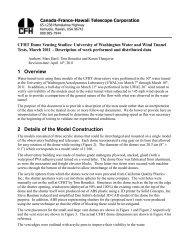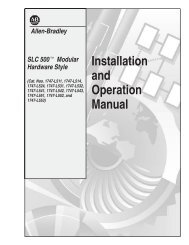Documentation [PDF] - Canada France Hawaii Telescope ...
Documentation [PDF] - Canada France Hawaii Telescope ...
Documentation [PDF] - Canada France Hawaii Telescope ...
You also want an ePaper? Increase the reach of your titles
YUMPU automatically turns print PDFs into web optimized ePapers that Google loves.
according to the fringe amplitudes measured on one hundred peak-valley pairs on each CCD. Since all<br />
CCDs see the same sky and since the photometric zero-point is uniform across the entire field of view,<br />
a single scaling factor is derived from the 36 CCDs. The scaled exposures are stacked, and an iterative<br />
process similar to the one described above is carried out, with a visual control allowing the rejection<br />
of frames containing extended astrophysical sources such as large galaxies. The fringe correction is<br />
challenging at times in the z-band and some images get only partially corrected due to the extreme<br />
behavior of the OH emission lines in the upper atmosphere which cause a signature too different from<br />
the run master fringe frame. (A different observing strategy such as the one adopted for the MegaCam<br />
Next Generation Virgo Survey would have helped but was not available during CFHTLS observations.)<br />
Consequently the defringing recipe is unchanged for the T0007 data collection. All fringe patterns were<br />
however re-created since they must include the signature of the new photometric B5/SNLS flat-fields.<br />
After these detrending steps, Elixir processes all the images of the run, and derives an astrometric solution<br />
per CCD only, at the pixel scale level (0.2 ′′ ). The goal at the Elixir level is to provide the users with a<br />
first order astrometric solution and no global solution over the mosaic is computed; this is a task handled<br />
by Terapix.<br />
Following this step, all the frames containing Smith et al. (2002) photometric standards (the CFHT QSO<br />
“Q97” program. Please refer to the description of the Observing Programs Identificators 10 ) are identified<br />
and processed using SExtractor. A median zero-point for the entire run is derived for each filter, since<br />
not enough observing time is available to derive enough standard star observations per night to derive<br />
solid zero-point solutions. Again, the intention is to provide MegaCam users with a reliable photometric<br />
scaling, offering a precision at the 4% level in absolute. But then again, since this default calibration was<br />
clearly not precise enough for their needs, the SNLS team developed in collaboration with CFHT new<br />
procedures to calibrate the images. This vast undertaking is the key to major improvements in T0007<br />
compared to T0006: all knowledge acquired for the SNLS survey has been passed to the Deep and the<br />
Wide surveys. This calibration effort is described in detail in Section 3.7.<br />
3.3 Overview of T0007 processing at Terapix<br />
TERAPIX processing steps from the download of Elixir pre-processed CFHT images to the final stacked<br />
images and catalogues is illustrated in Fig. 3. The T0007 CFHTLS pre-processed images described in the<br />
previous section were transferred from CFHT and validated against the T0007 image lists. All Queued<br />
Service Observing validation flags archived at CFHT were also downloaded 11 .<br />
For the T0007 release we use Elixir “B5/SNLS” pre-reduced images. The images were first ingested<br />
with the Terapix processing pipeline YOUPI, producing weight-maps and input catalogues. We use quality<br />
grades from previous CFHTLS releases for images which were already in the database; new images from<br />
the “L99” photometric calibration program and the VIPERS Director’s Discretionary Time observations<br />
(described later) were graded using the Youpi grading interface, described below.<br />
Images were then divided into each of the four Wide and four Deep fields and processed with SCAMP<br />
(Bertin, 2006) in order to derive the astrometric as well as the initial photometric calibrations. As explained<br />
below, as a consequence of the new calibration scheme based on L99 images, the astrometric and<br />
photometric calibrations were performed separately.<br />
Once aligned astrometrically, images are co-added by SWARP (Bertin et al., 2002) using the SCAMP initial<br />
photometric rescaling. For the Deep field, images lists are derived using seeing and photometric rescaling<br />
10 http://www.cfht.hawaii.edu/Science/CFHTLS-DATA/cfhtlsprograms.html<br />
11 http://www.cfht.hawaii.edu/Science/CFHTLS-DATA<br />
3


![Documentation [PDF] - Canada France Hawaii Telescope ...](https://img.yumpu.com/26965302/15/500x640/documentation-pdf-canada-france-hawaii-telescope-.jpg)









